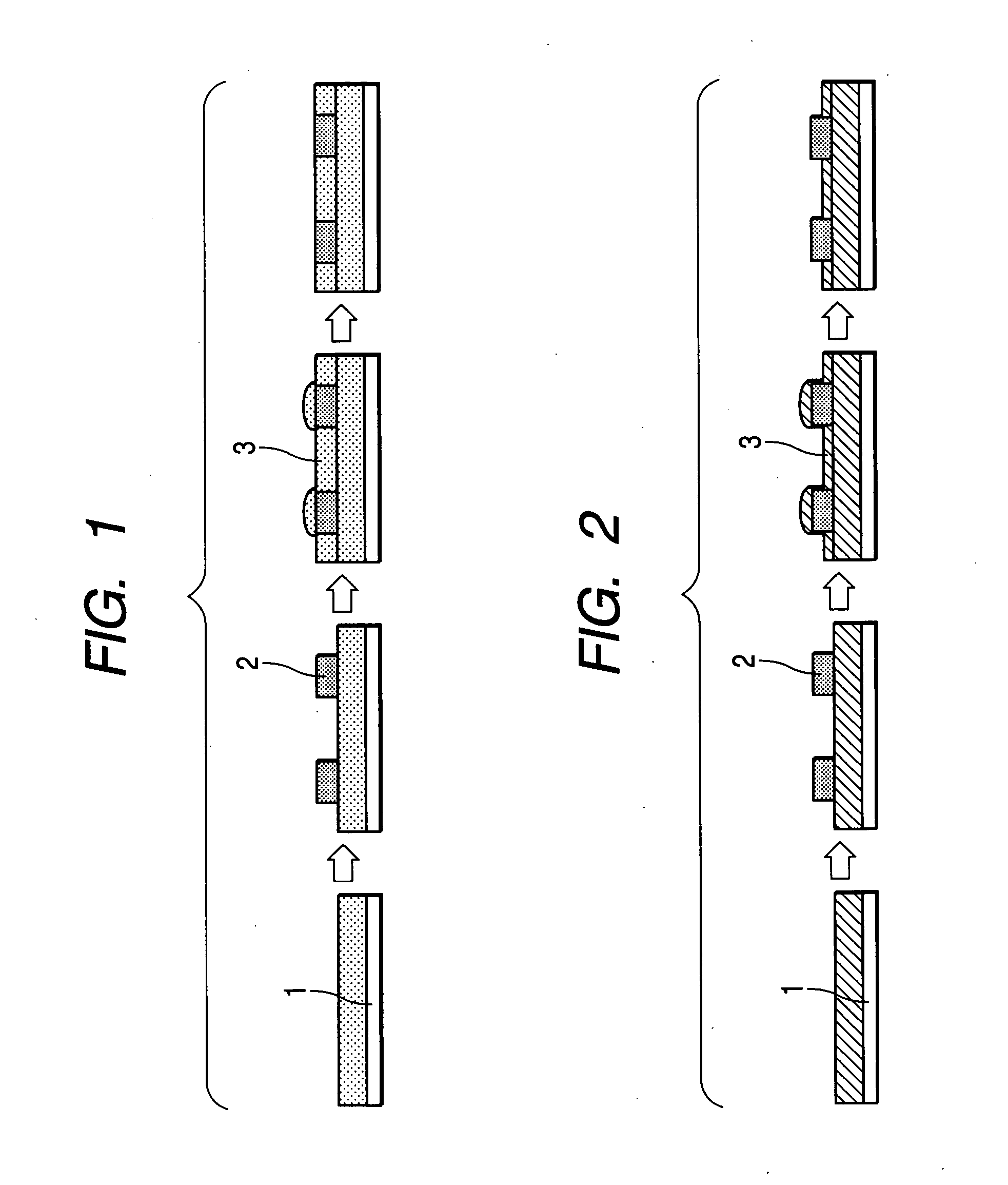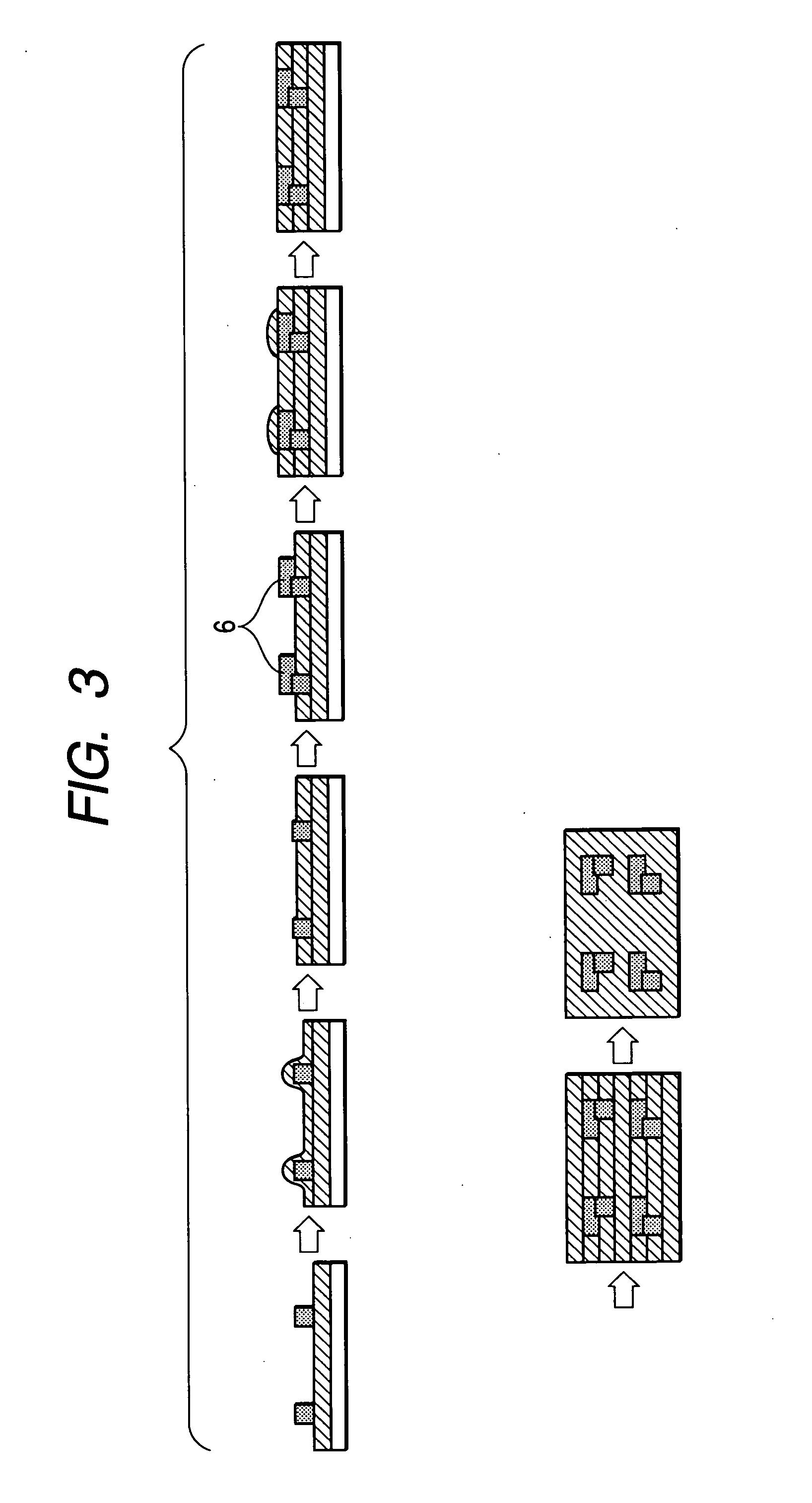Multilayer ceramic electronic part, circuit board and method for producing ceramic green sheet used for manufacturing those part and circuit board
a multi-layer ceramic and electronic part technology, applied in the direction of fixed capacitors, metallic pattern materials, fixed inductances, etc., can solve the problems of light transmisivity, parts that need not be exposed, and lack of sharpness at the edge of the outer shape, so as to improve the electric characteristics of the parts, reduce the misalignment of the spherical part, and improve the precision of the dimension of the sintered member
- Summary
- Abstract
- Description
- Claims
- Application Information
AI Technical Summary
Benefits of technology
Problems solved by technology
Method used
Image
Examples
embodiment 1
[0040] As shown in FIG. 1, internal electrodes 2 having a predetermined thickness are formed on a substrate 1 by a discretional process. Then slurry of a photosensitive ceramic 3 is applied on the surface of the internal electrodes. The slurry is dried so that the thickness thereof just before exposure will be substantially equal to the thickness of the internal electrodes. Subsequently, the photosensitive ceramic slurry is irradiated with light from the upper side of the substrate to effect exposure while the internal electrode pattern is masked by a photo mask 4 as shown in FIG. 4. In this process, the surface of the photosensitive ceramic slurry is selectively hardened while controlling the exposure amount in such a way that the exposed portion on the surface of the photosensitive ceramic slurry is hardened. The portion of the photosensitive ceramic slurry that has not been exposed is removed by development process to produce a substantially flat layer incorporating internal elec...
embodiment 2
[0044] As shown in FIG. 2, internal electrodes 2 having a predetermined thickness 2 are formed on a substrate 1 by a discretional process. Then slurry of a photosensitive ceramic 3 is applied on the surface of the internal electrodes. The slurry is dried so that the thickness thereof just before exposure will be smaller than the thickness of the internal electrodes. Subsequently, the photosensitive ceramic slurry is irradiated with light from the upper side of the substrate to effect exposure while the internal electrode pattern is masked by a photo mask 4 as shown in FIG. 4. In this process, the surface of the photosensitive ceramic slurry is selectively hardened while controlling the exposure amount in such a way that the exposed portion on the surface of the photosensitive ceramic slurry is hardened. The portion of the photosensitive ceramic slurry that has not been exposed is removed by development process to expose the internal electrode pattern.
[0045] Circuit boards or electr...
embodiment 3
[0046] As shown in FIG. 3, internal electrodes 2 having a predetermined thickness are formed on a substrate 1 by a discretional process. Then slurry of a photosensitive ceramic 3 is applied on the surface of the internal electrodes. The slurry is dried so that the thickness thereof just before exposure will be smaller than the thickness of the internal electrodes. Subsequently, the photosensitive ceramic slurry is irradiated with light from the upper side of the substrate to effect exposure while the internal electrode pattern is masked by a photo mask 4 as shown in FIG. 4. In this process, the surface of the photosensitive ceramic slurry is selectively hardened while controlling the exposure amount in such a way that the exposed portion on the surface of the photosensitive ceramic slurry is hardened. The portion of the photosensitive ceramic slurry that has not been exposed is removed by development process to expose the internal electrode pattern. On the post electrodes thus forme...
PUM
 Login to View More
Login to View More Abstract
Description
Claims
Application Information
 Login to View More
Login to View More - R&D
- Intellectual Property
- Life Sciences
- Materials
- Tech Scout
- Unparalleled Data Quality
- Higher Quality Content
- 60% Fewer Hallucinations
Browse by: Latest US Patents, China's latest patents, Technical Efficacy Thesaurus, Application Domain, Technology Topic, Popular Technical Reports.
© 2025 PatSnap. All rights reserved.Legal|Privacy policy|Modern Slavery Act Transparency Statement|Sitemap|About US| Contact US: help@patsnap.com



